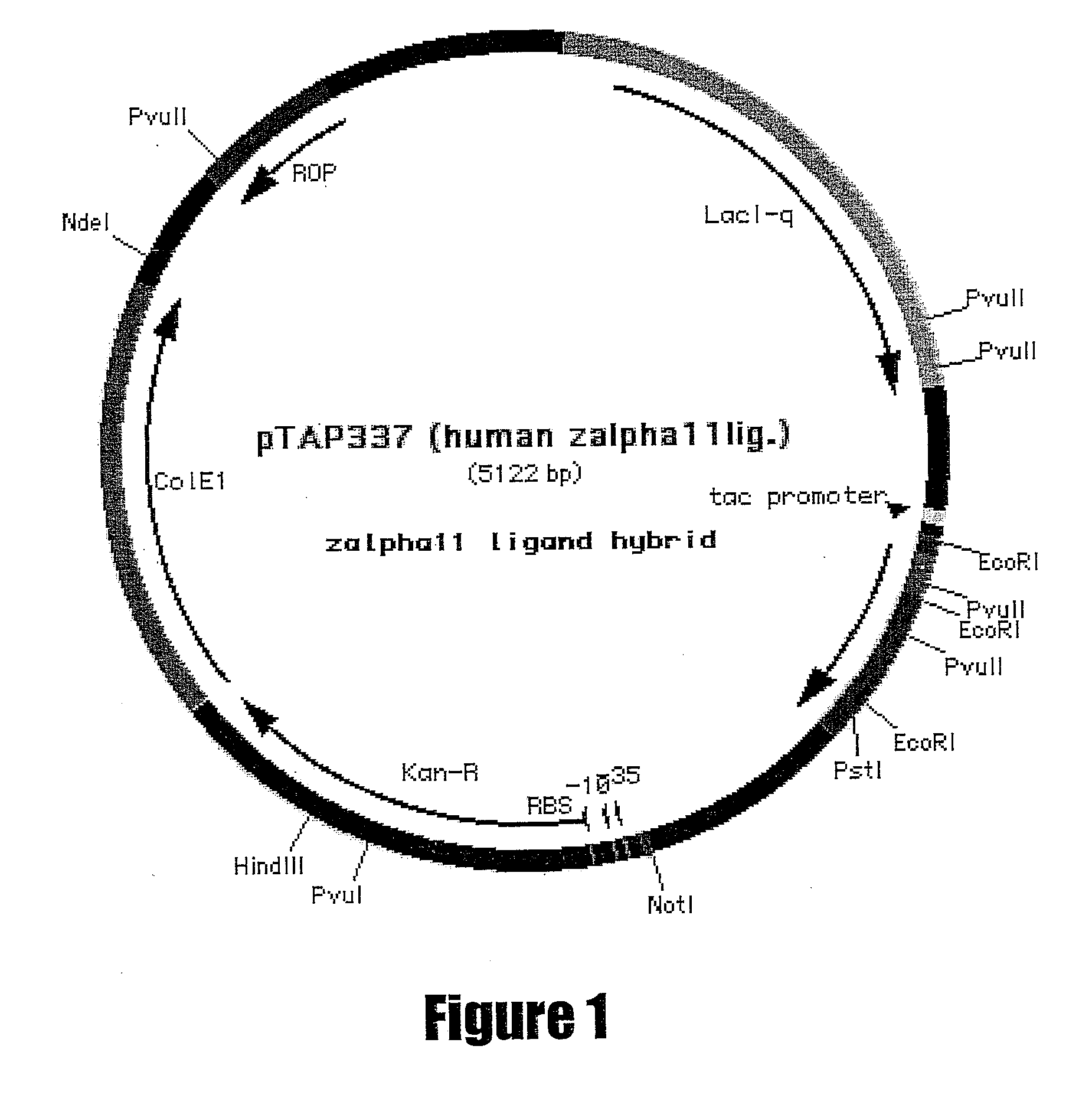Il-21 production in prokaryotic hosts
a prokaryotic host and il-21 technology, applied in animal/human proteins, peptide/protein ingredients, peptides, etc., can solve the problems of difficult high-level production of functional proteins in e. coli, /i>especially those from eukaryotic sources
- Summary
- Abstract
- Description
- Claims
- Application Information
AI Technical Summary
Benefits of technology
Problems solved by technology
Method used
Image
Examples
example 1
Construction of Expression Vector, pTAP237
[0105] Plasmid pTAP237 was generated by inserting a PCR-generated linker into the SmaI site of pTAP186 by homologous recombination. Plasmid pTAP186 was derived from the plasmids pRS316 (a Saccharomyces cerevisiae shuttle vector) and pMAL-c2, an E. coli expression plasmid derived from pKK223-3 and comprising the tac promoter and the rrnB terminator. Plasmid pTAP186 contains a kanamycin resistance gene in which the SmaI site has been destroyed and has NotI and SfiI sites flanking the yeast ARS-CEN6 and URA3 sequences, facilitating their removal from the plasmid by digestion with NotI. The PCR-generated linker replaced the expression coupler sequence in pTAP186 with the synthetic RBS II sequence. It was prepared from 100 pmoles each of oligonucleotides zc29,740 and zc29,741, as shown in SEQ ID NOS: 3 and 4, respectively, and approximately 5 pmoles each of oligonucleotides zc29,736 and zc29,738, as shown in SEQ ID NOS: 5 and 6, respectively. T...
example 2
Construction of pTAP252
[0106] The human IL-21 coding sequence (as shown in SEQ ID NO:1) was generated by PCR amplification using a CD3+ cDNA library pool as template and oligonucleotide primers zc29,084 and zc22,127 (SEQ ID NOS: 7 and 8, respectively). To optimize the translation process in E. coli, primer zc29,084 (SEQ ID NO:7) added an ATG initiation codon to the 5′ end of the IL-21 coding sequence. The resulting gene sequence encoded the mature IL-21 with one extra methionine at the N-terminus (IL-21met). The final PCR product was inserted into expression vector pTAP237 (described in Example 1) by yeast homologous recombination (Raymond et al., Biotechniques. 26(1):134-8, 140-1, 1999; U.S. Pat. No. 6,027,442, incorporated herein by reference). The expression construct, pTAP252, was extracted from yeast and transformed into competent E. coli MC1061. Kanamycin resistant clones were identified by colony PCR. A positive clone was verified by sequencing and subsequently transformed ...
example 3
[0107] Induction of expression of human IL-21met from pTAP252 produced about 2-5% of total cellular protein in E. coli strain E104. Examination of the codons used in the IL-21 coding sequence indicated that it contained an excess of the least frequently used codons in E. coli with a CAI value equal to 0.181. The CAI is a statistical measure of synonymous codon bias and can be used to predict the level of protein production (Sharp et al., Nucleic Acids Res. 15(3):1281-95, 1987). Genes coding for highly expressed proteins tend to have high CAI values (>0.6), while proteins encoded by genes with low CAI values (E. coli. Additionally, the rare codons are clustered in the second half of the message leading to higher probability of translational stalling, premature termination of translation, and amino acid misincorporation (Kane J F. Curr. Opin. Biotechnol. 6(5):494-500, 1995).
[0108] It has been shown that the expression level of proteins whose genes contain rare cod...
PUM
| Property | Measurement | Unit |
|---|---|---|
| pH | aaaaa | aaaaa |
| concentration | aaaaa | aaaaa |
| concentration | aaaaa | aaaaa |
Abstract
Description
Claims
Application Information
 Login to View More
Login to View More - R&D
- Intellectual Property
- Life Sciences
- Materials
- Tech Scout
- Unparalleled Data Quality
- Higher Quality Content
- 60% Fewer Hallucinations
Browse by: Latest US Patents, China's latest patents, Technical Efficacy Thesaurus, Application Domain, Technology Topic, Popular Technical Reports.
© 2025 PatSnap. All rights reserved.Legal|Privacy policy|Modern Slavery Act Transparency Statement|Sitemap|About US| Contact US: help@patsnap.com

